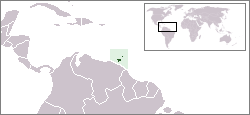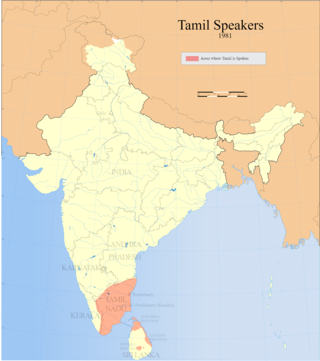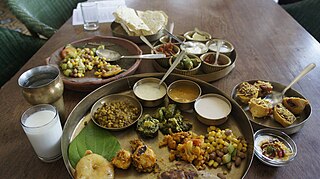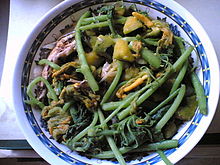
Thai eggplant is the name for several varieties of eggplant used in Southeast Asian cuisines, most often of the eggplant species Solanum melongena. They are also cultivated in India and Sri Lanka and feature in Sri Lankan cuisine. These golf ball-sized eggplants are commonly used in Thai cuisine, Indonesian cuisine, and in Cambodian cuisine. Some cultivars in Thailand include Thai Purple, Thai Green, Thai Yellow, and Thai White.

Trinidad and Tobago cuisine is influenced by Indian-South Asian, West African, Creole, European, North American, Chinese, Amerindian, Latin American, and Levantine culinary styles.

Tamil cuisine is a culinary style of Tamil people originating in the southern Indian state of Tamil Nadu and neighboring Sri Lanka. Meats, along with rice, legumes, and lentils, are popular. Dairy products and tamarind are used to provide sour flavors. On special occasions, traditional Tamil dishes are served in a traditional manner, using banana leaves in place of utensils. After eating, the banana leaves are then used as a secondary food for cattle. A typical breakfast meal consists of idli or dosa with chutney. Lunch includes rice, sambar, curd, kuzhambu, and rasam.

Iraqi cuisine is a Middle Eastern cuisine that has its origins in the ancient Near East culture of the fertile crescent. Tablets found in ancient ruins in Iraq show recipes prepared in the temples during religious festivals—the first cookbooks in the world. Ancient Iraq's cultural sophistication extended to the culinary arts.

Assyrian cuisine is the cuisine of the indigenous ethnic Assyrian people, Eastern Aramaic-speaking Syriac Christians of Iraq, northeastern Syria, northwestern Iran and southeastern Turkey. Assyrian cuisine is primarily identical to Iraqi/Mesopotamian cuisine, as well as being very similar to other Middle Eastern and Caucasian cuisines, as well as Greek cuisine, Levantine cuisine, Turkish cuisine, Iranian cuisine, Palestinian cuisine, and Armenian cuisine, with most dishes being similar to the cuisines of the area in which those Assyrians live/originate from. It is rich in grains such as barley, meat, tomato, herbs, spices, cheese, and potato as well as herbs, fermented dairy products, and pickles.
Maharashtrian or Marathicuisine is the cuisine of the Marathi people from the Indian state of Maharashtra. It has distinctive attributes, while sharing much with other Indian cuisines. Traditionally, Maharashtrians have considered their food to be more austere than others.

Gujarati cuisine is the cuisine of the Indian state of Gujarat. The typical Gujarati thali consists of rotli, dal or curry, rice, and shaak. The thali will also include preparations made from pulses or whole beans such as moong, black eyed beans etc., a snack item (farsaan) like dhokla, pathra, samosa, fafda, etc. and a sweet (mishthaan) like mohanthal, jalebi, sevaiya etc.

The cuisine of the Democratic Republic of the Congo varies widely, representing the food of indigenous people. Cassava, fufu, rice, plantain and potatoes are generally the staple foods.

Undhiyu is a Gujarati mixed-vegetable dish that is a regional specialty of Surat, Gujarat, India. The name of this dish comes from the Gujarati word undhu, which translates to 'upside-down', since the dish is traditionally cooked upside-down underground in earthen pots called matlu (માટલું) that are fired from above. When made in matlu, the dish is called umbadiyu.

Pinakbet is an indigenous Filipino dish from the northern regions of the Philippines. Pinakbet is made with a variety of mixed vegetables flavored with bagoóng. The word is the contracted from the Ilokano word pinakebbet, meaning "shrunk" or "shriveled."

Kinilnat, or ensalada, is an Ilocano salad. Unlike some Western salads, kinilnat accompanies the main course as a side dish.

Khoresh or Khoresht is an Iranian term for stew dishes of the Persianate World in Iranian cuisine, Afghan cuisine, Tajik cuisine and also Kurdish cuisine. The word is a substantive of the verb khordan "to eat" and literally means "meal".
Bhojpuri cuisine is a style of food preparation common among the Bhojpuri people of Bihar, Jharkhand and eastern Uttar Pradesh in India, and also the Terai region of Nepal. Bhojpuri foods are mostly mild and tend to be less hot in terms of spices used. The cuisine consists of both vegetable and meat dishes.

Haitian cuisine is a Creole cuisine that originates from a blend of several culinary styles that populated the western portion of the island of Hispaniola, namely African, French, indigenous Taíno, Spanish, and Arab influences. Haitian cuisine has some similarities with "criollo" cooking and similar to the rest of the Caribbean, but differs in several ways from its regional counterparts. Flavors are bold and spicy demonstrating African and French influences, with notable derivatives coming from native Taíno and Spanish techniques.
Ladera, zeytinyağlı (yemekler) (Turkish), or bil zayt is a category of vegetable dishes cooked in olive oil in Greek, Turkish, and Arabic cuisines. The name in all these languages means "with (olive) oil".

Sinabawang gulay, usually anglicized as Filipino vegetable soup, is a Filipino vegetable soup made with leafy vegetables and various other vegetables in a broth seasoned with seafood stock or patis. The ingredients of the dish can vary widely. It is eaten on its own or over white rice.

Lugbara cuisine is one of the meals of East Africa and the ancient Lado Enclave. The Lugbara people of northwestern Uganda and northeastern DR Congo eat not only vegetable dishes, but also animals like goats, cows plus ope (guineafowls) and catch insects like onya for food which is called nyaka in the standard Lugbara language used in Arua. Cassava flour, sometimes mixed with millet or sorghum like posho or ugali, is the staple food and is called enya(sa) and accompanied with a range of soup dishes. Rice, yams, potatoes and matoke are also eaten. Below is a list of some of the Lugbara-styled delicacies found in West Nile Restaurants, Ariwara Town, Arua Park in Kampala and many homes or cafeterias that cherish traditional Lugbara cuisine.

Guinean cuisine includes traditional Guinean dishes such as fou fou, boiled mango, fried plantains, patates and pumpkin pie.








































